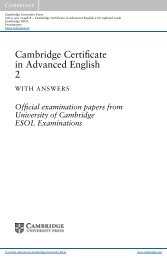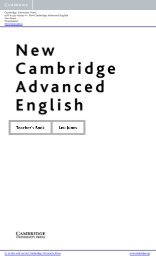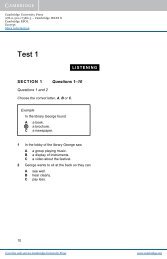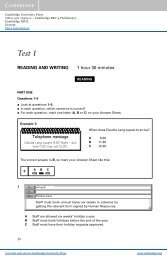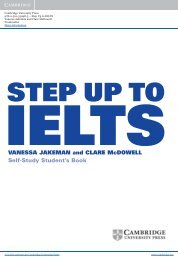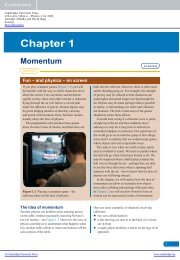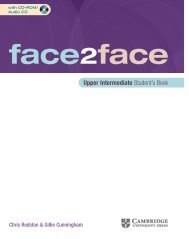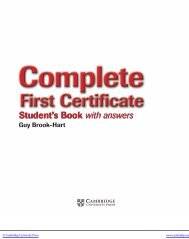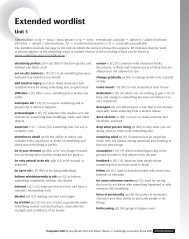Skills for Study Level 2 Teacher's Book - Cambridge University Press
Skills for Study Level 2 Teacher's Book - Cambridge University Press
Skills for Study Level 2 Teacher's Book - Cambridge University Press
Create successful ePaper yourself
Turn your PDF publications into a flip-book with our unique Google optimized e-Paper software.
2d Group workSuggested answersLab report: tends to be fixed. Deviations from this would be very unlikely.Feasibility / recommendation report: the requirements and presentationof options can be reversed, or even combined with the introduction andbackground.Progress report: the order given here is the most rational from a chronologicalpoint of view, but this is a very flexible report type, so arguably most of thesesections could be rearranged.2e Group discussion3 Writing a literature reviewNote: As the length and depth of analysis in a literature review will vary dependingon the type of text it appears in, this section is meant as a general introduction tothe concept of literature reviews rather than an exhaustive treatment of how towrite them.3aSuggested answers1 Definition and discussion of key terms2 Explanation of why the topic is important3 Identification of key problems4 Description of different solutions or approaches to answering the keyquestions that have been offered by other writers5 A conclusion summarizing the main points.Literature reviewJob satisfaction can be defined as a worker’s subjective assessment of theirhappiness with the work they do 1 . An understanding of what factors influence jobsatisfaction is critical <strong>for</strong> two reasons. Firstly, it can guide policy makers and thoseinvolved in the campaign <strong>for</strong> better working conditions, but also because higher jobsatisfaction is likely to lead to better work per<strong>for</strong>mance and lower turnover costs <strong>for</strong>employers 2 .Clark and Oswald (1996) were the first to create a model of the factors involved injob satisfaction. They drew a link between earned income and satisfaction, but alsointroduced the importance of expectations: greater job satisfaction is found wherethe gap between actual and expected wages is small. Clark and Oswald there<strong>for</strong>eclaimed that the amount of money earned is not, by itself, the most importantelement of job satisfaction. This has become particularly significant in the debateabout the sources of women’s satisfaction at work, and explanations <strong>for</strong> theso-called gender / job-satisfaction paradox 2 .It is widely accepted that women tend to have greater job satisfaction than men.This is often explained in part as being due to women having low expectations ofwhat they will be able to earn, or how likely they are to be promoted. If women donot have such high expectations of salary or career advancement as men do, thenit follows that they will be more satisfied with less attractive earnings and careeroutcomes. However, as Hammermesh (2000) notes, job expectations and actualwork experiences change during the course of a career, and so it is unlikely thatmale and female expectations are uni<strong>for</strong>mly different. This would seem to undermineClark and Oswald’s claim <strong>for</strong> low expectations, though findings from a large body ofstudies following Clark suggest that it is at least part of the reason 3 .Unit 1 Part E ∙ Reporting in writing 33



